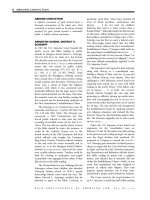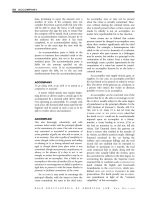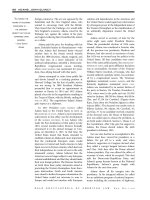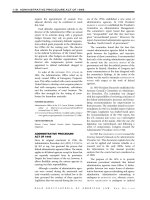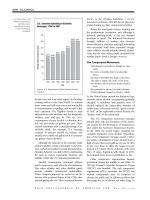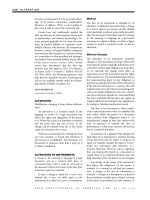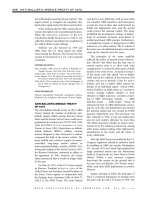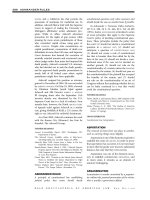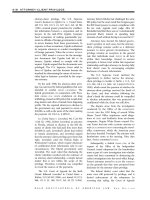Gale Encyclopedia Of American Law 3Rd Edition Volume 3 P55 ppsx
Bạn đang xem bản rút gọn của tài liệu. Xem và tải ngay bản đầy đủ của tài liệu tại đây (484.35 KB, 10 trang )
amenable to SERVICE OF PROCESS unless it has a
substantial and regular relationship with the
state comparable to the residency of an
individual, such as having its corporate head-
quarters in the forum state. In cases involving
subsidiary corporations, the intrastate business
engaged in by a subsidiary is sufficient to make
its parent corporation amenable to process in
the state because the parent corporation is
deemed to be doing business in the state.
The laws of each state must be consulted
to determine whether a foreign corporation
is doing business within a state to make it
amenable to process therein.
The phrase doing business is sometimes
used in the assessment of local taxes upon a
nonresident corporation in jurisdictions ot her
than the place of its incorporation i n which it
engages in business.
v
DOLE, ROBERT JOSEPH
Robert Joseph “Bob” Dole overcame childhood
poverty and a wartime injury that left him
partially paralyzed to become one of the most
powerful players in national politics. The
Republican majority leader from Kansas often
won praise from Republicans and Democrats
alike for finding a middle course through
difficult issues. His long career in national
politics put him at the center of major legislative
debates; and whether in budgetary, social, or
foreign policy matters, he often bridged party
differences. These battles made him not only a
skilled negotiator but, by the 1990s, the most
powerful leader in his party. His politics were
generally characterized by economic conserva-
tism, support for
CIVIL RIGHTS, and moderation
on social issues. In addition to being a vice
presidential candidate in 1976, Dole mounted
three presidential campaigns, in 1980, 1988,
and 1996.
Robert Joseph Dole 1923–
▼▼
◆
1923 Born,
Russell, Kans.
❖
1943–48 Served
in U.S. Army
1945 Earned Purple Heart after
being seriously injured
▼▼
◆◆
◆
◆
◆◆
1950–53
Korean War
1961–73
Vietnam War
1960–68 Served in
U.S. House
1971
Appointed
RNC
chair
1976 Ran
for vice
president
with Ford
1984 Elected
Senate majority
leader
1988 Ran for
Republican
presidential
nomination
1996 Retired
from Senate to
run for
president;
lost election
to Clinton
1968–96 Served in U.S. Senate
1980 Ran for Republican
presidential nomination
2003 Joined
law firm
Alston &
Bird,
Atlanta, Ga.
1998–99 Co-chaired bipartisan commission
studying federal Independent Counsel Statute
1997 Awarded Presidential Medal of Freedom
1999 Federal Independent Counsel Act allowed to expire
2000 Wife Elizabeth Dole lost bid for Republican presidential nomination
2002 Elizabeth Dole elected U.S. senator, North Carolina
2005
One Soldier's
Story:
A Memoir
published
2000
1975
1950
1939–45
World War II
◆◆◆◆◆◆
1925
Bob Dole.
STAN HONDA/AFP/GETTY IMAGES
GALE ENCYCLOPEDIA OF AMERICAN LAW, 3
RD E DITION
528 DOLE, ROBERT JOSEPH
The values of Dole’s working-class family
informed his upbringing. He was born on July
22, 1923, in Russell, Kansas, the son of an egg
and cream station owner, Doran Ray Dole, and
a traveling sewing machine saleswoman, Bina
Talbot Dole. An athletic young man, Dole
excelled in football, basketball, and track. He
worked at several jobs and wanted to be a
doctor. At age 18, he enrolled in the pre-med
program at the University of Kansas. Drafted
two years later, in 1943, he found himself
fighting in Italy.
WORLD WAR II had almost ended
in April 1945 when a shell hit him on
the battlefield, smashing his neck, shoulder,
and spine. Doctors thought he would be
crippled. But Dole’s persistence through three
years of operations and the rapy brought an
amazing recovery. His only permanent dis-
abilities are a lack of control of h is right
arm and hand, and partial loss of control of
his l eft.
The 25-year-old survivor was transformed.
With new earnestness, he finished his under-
graduate studies at the University of Arizona
and earned a law degree with honors from
Washburn University of Topeka.
Law quickly led to politics. Dole served
one term in the Kansas Legislature in 1951, and
for the remainder of the decade worked as a
PROSECUTOR in his local county. He entered
national politics in 1960 with election to the
U.S. House of Representatives, where he won
reelection every two years through 1968. Dole
advocated fiscal conservatism while supporting
limited welfare spending. He voted against the
GREAT SOCIETY programs of President LYNDON B.
JOHNSON, but he supported aid to hungry and
disabled persons and to farmers. He strong ly
backed civil rights legislation, a position from
which he never wavered throughout his career.
His model in politics—and the figure who
ultimately became his mentor—was
RICHARD
M
. NIXON, a friend since the 1950s. Dole’s
election to the U.S. Senate in 1968 gave President
Nixon a vociferous supporter, and earned Dole
the post of Republican National Committee
(RNC) chairman in 1971.
The 1970s and 1980s brought Dole promi-
nence in national politics. One reason for this
was his marriage in 1975 to Elizabeth Hanford,
an accomplished Harvar d graduate who later
held the posts of secretary of transportation
and secretary of labor. Dole’s chairmanship of
the RNC also brought dividends. In 1976
President
GERALD R. FORD chose Dole as his vice
presidential running mate in an unsuccessful
bid for reelection. The 1976 race whetted Dole’s
appetite for more , and he mounted his own
campaign for president in 1980, losing out to
RONALD REAGAN.
In 1984 Dole was elevated to Senate
majority leader. Although his function in this
role was to deliver party loyalty on votes in the
Senate, he also became a strong supporter of
President Reagan. During the Iran-Contra
scandal, Dole took a leading role in damage
control. He made public reassurances and
traveled the United States to rally support for
the president.
Dole made another bid for president after
Reagan’s departure in 1988. This unsuccessful
struggle for the Republican nomination against
Vice President George H. W. Bush revealed
what many critics had long seen as a mixed
blessing in Dole: his acerbic tongue. This had
appeared as an issue as early as 1976, when,
while campaigning as Gerald Ford’s running
mate, Dole had ridiculed Democratic candidate
JIMMY CARTER as “Southern Fried McGovern.” In
1988, again while campaigning, he lashed out at
George H. W. Bush on national TV, saying Bush
had lied about him. The attack on Bush raised
some speculation about whether Dole could
control his temper.
In 1996 Dole’s third run for the White
House was characterized by a rightward shift.
Soon after declaring his candidacy, he attacked
Hollywood for making movies that “revel in
mindless violence and loveless sex.” Dole called
for making English the nation’s official lan-
guage, returned the campaig n contribution of a
gay Republican organization (later calling the
move a mistake), and quit attending a United
Methodist church that conservative critics had
denounced as excessively libera l.
More crucially, perhaps, Dole’s ideas on
economics now resembled those that he had
found untenable in President Reagan. The
senator who had won bipartisan praise for a
1982 tax compro mise now told voters, “We can
cut taxes and balance the budget at the same
time.” And less apparent was his trademark
willingness to compromise: Throughout late
1995 and early 1996, Dole and House Majority
Leader Newt Gingrich (R-Ga.) engaged in a
budget deadlock with President
BILL CLINTON
THE GOVERNMENT
CANNOT DIRECT THE
PEOPLE
, THE PEOPLE
MUST DIRECT THE
GOVERNMENT
.
—BOB DOLE
GALE ENCYCLOPEDIA OF AMERICAN LAW, 3RD E DITION
DOLE, ROBERT JOSEPH 529
that forced a shutdown of the federal govern-
ment. He lost the 1996 election to Clinton.
Although he retired from elective politics in
1996, Dole remained active. In 1997 President
Clinton awarded Dole the Presidential Medal
of Freedom, the nation’s highest civilian award.
That same year, Dole was appointed chair of the
International Commission on Missing Persons,
an organization established to help find infor-
mation on the fates of thousands of persons
missing in the former Yugoslavia; and chair of
the National World War II Memorial, the first
national memorial dedicated to those who
served in World War II. He also helped establish
the
ROBERT J. DOLE Institute of Politics at the
University of Kansas. In 1998 he campaigned
in 37 states for Republican candidates; in 2000
he was active in George W. Bush’s cam paign
for the presidency; and in 2002 he worked on
the successful senatorial campaign of his wife
Elizabeth.
After the September 11, 2001, attack on the
World Trade Cen ter, Dole joined with Clinton,
his former political rival, as co-chair of a
scholarship fund that raised money to provide
education assistance to the families of persons
killed or wounded in the terrorist attacks. In
2003 Dole began a series of appearances with
Clinton on the CBS news show Sixty Minutes.
The format of the segment, two-minute debates
on highly topical subjects, was based on the
show’s highly popular Point/Counterpoint seg-
ments that aired in the 1970s. Noting that both
his wife and President Clinton’s wife were
freshman senators, Dole quipped that they had
permission to do the show, “We both cleared
it with our wives so we won’t get into trouble.”
Dole’s memoir came out in 2005. In addition
to practicing law after he left the Senate, in
March 2007 Dole was named by President Bush
to oversee a commission to investigate poor
conditions at Walter Reed Army Medical
Center.
FURTHER READINGS
Bob Dole website. Available online at www.bobdole.org
(accessed August 17, 2009).
Dole, Bob. 2005. One Soldier’s Story: A Memoir. New York:
HarperCollins.
Moraes, Lisa. 2003. “Clinton and Dole Agree to
Disagree Weekly on ‘Sixty Minutes.’” Washington Post
(March 6).
The Robert J. Dole Institute of Politics. Available online at
www.ku.edu/~dole (accessed August 17, 2009).
v
DOLE, SANFORD BALLARD
Sanford Ballard Dole was a prominent figure
in the creation of Hawaii as a republic and its
annexation to the United States. Dole was born
in 1844. His parents were American miss ion-
aries assigned to Hawaii, and Dole was raised
and educated there. After attending Williams
College and his admission to the Massachusetts
bar in 1868, he settled in Hawaii and began his
law practice.
In 1884 and 1886 he served in the Hawaiian
Legislature. His first act of dissension against
the existing monarchy was as a leader of the
Bayonet Revolution in 1887. As a result, the
power of the monarchy was reduced and a more
equitable constitution was adopted.
Also in 1887, Dole sat on the bench of the
Hawaii Supreme Court as an associate justice.
Sanford Ballard Dole 1844–1926
❖
◆◆
1844 Born,
Honolulu, Hawaii
1884, 1886 Served in
Hawaiian legislature
1894 Republic of
Hawaii created
1894–1900 Served as president of the Republic of Hawaii
1904–15 Served as justice of the U.S. district court for Hawaii
1914–18
World War I
1926 Died,
Honolulu, Hawaii
1861–65
U.S. Civil War
1893 Queen Liliuokalani overthrown;
Dole leader of revolutionary government
1900–03 Served as first governor of Territory of Hawaii
1939–45
World War II
❖
1887 Led the Bayonet Revolution,
resulted in more equitable
constitution for Hawaii
1898 Hawaii annexed
by United States
▼▼
▼▼
19001900
19251925
1950 1950
18501850
18751875
1866–68 Attended
Williams College in Mass.
1887–93 Presided as associate justice on the Hawaii Supreme Court
◆◆
◆
◆
THE UPRISING OF A
SMALL PEOPLE MAY
BE AS INSPIRING AS
THE UPRISING OF A
GREAT NATION
.
—SANFORD DOLE
GALE ENCYCLOPEDIA OF AMERICAN LAW, 3RD E DITION
530 DOLE, SANFORD BALLARD
In 1893 Queen Liliuokalani refused to recog-
nize the l imitations imposed upon h er by the 1887
constitution. An insurrection occurred and the
queen was overthrown. Dole left his post as justice
to become the leader of the revolutionary p rovi-
sional government that replaced the m onarchy.
The republic of Hawaii was created in 1894,
and Dole acted as its president. He began his
efforts for the U.S. annexation of Hawaii, but
his first attempts were thwarted by President
Grover Cleveland, who opposed the deposition
of the monarchy. Dole wrote a
TREATISE defend-
ing the revolution and its results but to no
avail. He was finally able to achieve annexation
under the administration of President
WILLIAM
MCKINLEY
in 1898. Dole continued to serve as
president throughout these years.
With the annexation of Hawaii completed,
Dole became the first governor of the newly
formed Territory of Hawaii. He performed
these duties from 1900 to 1903.
In 1904 Dole returned to the judiciary and
served as justice of the U.S. district court for
Hawaii until 1915. He died in Hawaii in 1926.
DOMAIN
The complete and absolute ownership of land.
Also the real estate so owned. The inherent
sovereign power claimed by the legislature of a
state, of controlling private property for public
uses, is termed the right of eminent domain.
National domain is sometimes applied to the
aggregate of the property owned directly by a nation.
Public domain embraces all lands, the title to which is
in the United States, including land occupied for the
purposes of federal buildings, arsenals, dock-yards,
and so on, and l and of a n agricultural or mineral
character not yet granted to p rivate owners.
Sphere of influence. Range of control or rule;
realm.
DOMBEC
[Saxon, Jud gment book.] The name given by the
Saxons to the code of laws by which they lived.
Several Saxon kings published dombecs,
also spelled dombocs. Dombecs were also known
as dome-books or doom-books. The
DOMBEC
compiled during the ninth-century reign of
Alfred the Great was among the most important
because it contained the law for the entire
kingdom of England, encom passing the princi-
pal maxims of
COMMON LAW, the penalties for
crimes, and the forms of judicial proceedings.
A dombec is not the same as the
DOMESDAY
BOOK
, although the two are often confused.
DOMESDAY BOOK
An ancient record of land ownership in England.
Commissioned by William the Conqueror in
the year 1085 and finished in 1086, the book is a
superb example o f thorough a nd speedy adminis-
tration, unequaled by any ot her p roject undert aken
during the Middle Ages. Minu te and accurate
surveys of all of England were d one for the purpose
of compiling information essential for l evying taxes
and e nforcin g the land t en ure system.
The work was done by five justices in each
county who took a census and listed all the
feudal landowners, their
PERSONAL PROPERTY, and
other information. The judges gathered their
information by summoning each man and
having him give testimony under
OATH. This is
perhaps the earliest use of the inquest procedure
in England, and it established the right of the
king to require citizens to give information, a
foundation of the jury trial.
Domesday was a Saxon word meaning
Judgment Day, at the end of time when God
will pronounce judgment against all of mankind.
The name given to this record may have come
Sanford B. Dole.
LIBRARY OF CONGRESS
GALE ENCYCLOPEDIA OF AMERICAN LAW, 3RD E DITION
DOMESDAY BOOK 531
from the popular opinion that the inquiry was
as thorough as that promised for Judgment Day.
Two volumes of the
DOMESDAY BOOK are still
in existence, and they continue to be valuable
for historical information about social and
economic conditions. They are kept in the
Public Record Office in Engla nd.
DOMESTIC
Pertaining to the house or home. A person employed
by a household to perform various servient duties.
Any household servant, such as a maid or butler.
Relating to a place of birth, origin, or domicile.
That which is domestic is related to house-
hold uses. A domestic animal is one that is
sufficiently tame to live with a family, such as a
dog or cat, or one that can be used to contribute
to a family’s support, such as a cow, chicken,
or horse. When something is domesticated, it
is converted to domestic use, as in the case of
a wild animal that is tamed.
Domestic relations are relationships betw een
various family members, such as a husband
and wife, that are regulated by
FAMILY LAW.
A domestic c orpor ation of a particular s tate is
one t hat h as been organized and chartered in that
state as opposed to a foreign corporation, w hich
has be en incorporated in another state o r territory.
In tax law, a domestic corporation is one that has
originated in any U .S. s tate or territory.
Domestic products are goods that are man-
ufactured within a particular territory rather
than imported from outside that territory.
DOMESTIC PARTNERSHIP LAW
The area of law that concerns the rights of unmarried
adults who choose to live together in the same manner
as a married couple but who are not married.
DOMESTIC PARTNERSHIP LAW is evolving rapidly, in
part because more individuals are choosing to
identify themselves as domestic partners. Although
any two adults living together in a loving
relationship may be called partners, the term i s
most frequently used to describe same-sex couples.
Since the 1990s, a number of local govern-
ments have enacted domestic partnership laws,
including Seattle, New York City, and Broward
County, Florida. In 1999 California passed a state
domestic partnership law that provided
a number of protections that formerly had
been offered only to married couples. These
protections include the right to inherit from a
partner’s estate; the right to mak e medical
decisions for an incap acitated partner; the right
to use sick leave to care for a partner; the right to
obtain
HEALTH INSURANCE through a partner; and
the right to adopt a partner’s child as a stepparent.
Domestic partners in California may obtain these
benefits by registering with the state.
Although domestic partnership law is
intended to provide benefits to partners, it still
represents uncharted territory and is far from
comprehensive or complete. Using the California
law as an example, a domestic partner is defined
as a committed member of a same-sex couple;
heterosexual couples who cohabit may not
register as domestic partners. The rationale is
that heterosexual couples in a committed rela-
tionship have the option of marriage, an option
that is not open to same-sex couples. The only
exception for heterosexual couples is when one
partner is age 62 or older, because frequently
SENIOR CITIZENS who cohabit run the risk of losing
part of their
SOCIAL SECURITY benefits if they marry.
A more problematic issue for domestic
partners is the fact that their partnership is
generally not recognized outside of their juris-
diction. Thus, their domestic partnership rights
are not binding if they should move to a
community that has no such laws of its own. In
fact, domestic partners who relocate to a new
community that does have protective laws are
advised to re-register in their new home in
order to eliminate any
AMBIGUITY.
As of 2009, a dozen states and dozens of
cities have civil union or domestic partnership
laws. Five states allow same-sex marriage.
CROSS REFERENCES
Adoption; Gay and Lesbian Rights; Family Law.
DOMESTIC VIOLENCE
Any abusive, violent, coercive, forceful, or threat-
ening act or word inflicted by one member of a
family or household on another can constitute
domestic violence.
Domestic violence, once considered one of
the most underreported crimes, became more
widely recognized during the 1980s and 1990s.
Various individuals and groups have defined
domestic violence to include everything from
saying unkind or demeaning words, to grabbing
a person’s arm, to hitting, kicking, choking, or
even murdering. Domestic violence most often
GALE ENCYCLOPEDIA OF AMERICAN LAW, 3RD E DITION
532 DOMESTIC
refers to violence between married or cohabit-
ing couples, although it sometimes refers to
violence against other members of a house-
hold, such as children or elderly relatives. (The
DEPARTMENT OF JUSTICE generally tracks victim/
offender relationships under the broader do-
mestic violence category.) It occurs in every
racial, socioeconomic, ethnic, and religious
group, although conditions such as poverty,
drug or alcohol abuse, and mental illness
increase its likelihood. Studies indicate that the
incidence of domestic violence among homo-
sexual couples is approximately equivalent to
that found among heterosexual couples.
Domestic violence involving famous married
or cohabiting couples tends to receive broad
media attention. (The Department of Justice
refers to these and similar incidents as “intimate
partner violence” and maintains separate statis-
tics for this sub-category as well.) The highly
publicized 1995 trial of former professional
football player and movie actor
O.J.(ORENTHAL
JAMES
) SIMPSON for the murders of his ex-wife
Nicole Brown Simpson and her friend Ronald
Lyle Goldman thrust it onto the front pages of
newspapers for many months. Simpson w as
acquitted of the
MURDER charges, but evidence
produced at his trial showed that he had been
arrested in 1989 for spousal battery and that he
had threatened to kill his ex-wife. The disclosure
that the prominent sports figure and movie star
had abused his wife prompted a national discus-
sion on the causes of domestic violence, its
prevalence, and effective means of eliminating it.
Like the case of O.J. Simpson , several of
these cases involved current or former athletes.
Jim Brown, who, like Simpson, was both a
famous football player and actor, received a
six-month sentence in 2000 for vandalizing his
wife’s car during an argument. Also like Simpson,
Brown had a history of alleged domestic-violence
incidents, though he had not be en convicted
in the previous allegations. In early 2009 NFL
quarterback Steve McNair was shot to death by
a girlfriend who then killed herself.
Although thousands of c ases involving domes-
tic violence occur each year, those that involve
celebrities continue to attract t he most at tention. In
1999 movie director John Singleton pled no-
contest to charges o f battering his girlfriend.
Singleton is b est k nown for such movies as Boyz
‘N the Hood and Poetic Justice. In 2001 Rae Carruth,
a player for the National Football League’sCarolina
Panthers, was found guilty of conspiracy to commit
the m urder of h is former girlfriend, who had been
carrying Carruth’schildatthetimeofherdeath.
Although he avoided the dea th penalty, Carruth
was sentenced to up to 25 years in prison. Also in
2001, former heavyweight boxing champion
Riddick Bowe was charged with third-degree
assault for a fight with his wife. Stil l another media
frenzy surrounded the 2009 assault on pop singer
Rihanna by her equally famous boyfriend, singer
Chris B rown.
Those who have studied domestic violence
believe that it usually occurs in a cycle with
three general stages. First, the abuser uses words
or threats, perhaps humiliation or ridicule. Next,
the abuser explodes at some perceived infraction
by the other person, and the abuser’s rage is
manifested in physical violence. Finally, the
abuser “cools off,” asks forgiveness, and promises
that the violence will never occur again. At that
point, the victim often abandons any attempt to
leave the situation or to have charges brought
against the abuser, although some prosecutors
will go forward with charges even if the victim is
unwilling to do so. Typically, the abuser’s rage
begins to build again after the
RECONCILIATION,
and the violent cycle is repeated.
In some cases of repeated domestic violence,
the victim eventually strikes back and harms
or kills the abuser. People who are repeatedly
Victims of Domestic Violence, by Relationship to Offender, 2006
SOURCE: U.S. Department of Justice, Bureau of Justice Statistics, Criminal
Victimization in the United States, 2006.
Other relative
35.2%
Spouse
30.8%
Ex-spouse
13.6%
Parent
7.4%
Own child
13.0%
Total number of domestic violence victimizations: 715,440
ILLUSTRATION BY GGS
CREATIVE RESOURCES.
REPRODUCED BY
PERMISSION OF GALE,
A PART OF CENGAGE
LEARNING.
GALE ENCYCLOPEDIA OF AMERICAN LAW, 3
RD E DITION
DOMESTIC VIOLENCE 533
victimized by spouses or other partners often
suffer from low self-esteem, feelings of shame
and guilt, and a sense that they are trapped in a
situation from which there is no escape. Some
who feel that they have no outside protection
from their batterer may turn to self-protection.
During the 1980s, in a number of cases in which
a victim of repeated domestic abuse struck back,
the battered-spouse defense was used to exon-
erate the victim. However, in order to rely on
the battered-spouse defense, victims must prove
that they genuinely and reasonably believed that
they were in immediate danger of death or
great bodily injury and that they used only such
force as they believed was reasonably necessary
to protect themselves. Because this is a very
difficult standard to meet, it is estimated that
fewer than one-third of victims who invoke
the battered-spouse defense are acquitted.
Heightened awareness and an increase in
reports of domestic v iolence have led t o a
widespread legal response since the 1980s. Once
thought to be a problem that was best handled
without legal intervention, domestic violence is now
treated as a criminal offense. Many states and
municipalities have instituted measures designed to
deal swiftly and harshly with domestic abusers. In
addition, governments have attempted to protect
the victims of domestic violence from fu rther
danger a nd have l aunched p rograms designed t o
address the root causes of this abuse. One example is
Alexandria, Virginia, which in 1994 began prose-
cuting repeat abusers under a Virginia law (Va. St.
§18.2–57.2 Code 1950, § 1 8.2–57.2) that makes the
third conviction for
ASSAULT AND BATTE RY a FELONY
punishable by up to five year s in prison. In addition,
the city esta blished a shelter for battered w omen, a
victims’ task force, and a domestic-violence inter-
vention program that includes a mandatory arrest
policy and court-ordered counseling. As a result,
domestic homicides in Alexandria d eclined from
40 percent of all homicides i n 1987 to 16 percent of
those b etween 1988 and 1994. Other states h ave
adopted similar measures. States that already had
specific laws d irected toward domestic violence
toughened the penalt ies. For example, a 1995
amendment to California’sdomestic-abuselaw
(West’s Ann. Cal. Penal Code §§ 14140–14143)
revokedaprovisionthatallowedfirst-timeabusers
to have their criminal record expunged if they
attended c ounseling.
At on e time, the marital
RAPE exemption
in many states prohibited criminal domestic
violence charges of rape made against a spouse,
i.e., by definition, a husband could not legally
rape his wife. Although all 50 states now crimi-
nalize spousal rape, many states still categorize
spousal rape as lesser offenses than those osten-
sibly committed by strangers.
Public outrage over domestic violence led to
the inclusion of the Violence Against Women
Act as title IV of the
VIOLENT CRIME CONTROL AND
LAW ENFORCEMENT ACT OF
1994 (Pub. L. No. 103-
322, 108 Stat. 1796 [codified as amended
in scattered sections of 18 and 42 U.S.C.A.]).
The act authorized research and education
programs for judges and judicial staff to enhance
knowledge and awareness of domestic violence
and sexual assault. It also provided funding for
police training and for shelters, increased penal-
ties for domestic violence and rape, and provided
for enhanced privacy protection for victims,
although the U.S. Supreme Court struck it down
as unconstitutional in 2000.
One of the more controversial portions of
the original act made gender-motivated crimes
a violation of federal
CIVIL RIGHTS law. In 2000
the U.S. Supreme Court considered the appli-
cation of this portion in United States v.
Morrison, 529 U.S. 598, 120 S. Ct. 1740, 146
L. Ed. 2d 658 (2000). In that case, a woman
brought suit against a group of University of
Virginia students who allegedly had raped her.
Although the district court found that the
woman had stated a claim against the respon-
dents, it held that Congress did not have
authority to enact the provision under the
COMMERCE CLAUSE or § 5 of the FOURTEENTH
AMENDMENT
to the U.S. Constitution. The U.S.
Court of Appeals for the Fourth Circuit affirmed
the decision, and the United States, which had
intervened to defend the statute, appealed to the
U.S. Supreme Court. The Court, per an opinion
by Chief Justice
WILLIAM H. REHNQUIST,agreedwith
the lower courts, holding the Congress had
exceeded its constitutional power. The result of
the case is that the civil-remedy provisions in
the original statute should fall under the purview
of the states, rather than the federal government.
The Supreme Court, in February 2009,
affirmed the application of the 1996 Lautenberg
Amendment to the Gun Control Act of 1968
(which prohibits gun ownership by anyone
convicted of a
MISDEMEANOR crime of domestic
violence, 18 U.S.C. 922(g)(9)), to cover anyone
convicted of any violent misdemeanor com-
mitted against a family member or dom estic
GALE ENCYCLOPEDIA OF AMERICAN LAW, 3RD E DITION
534 DOMESTIC VIOLENCE
partner (United States v. Hayes No. 07-608, 129
S.Ct. 1079, 172 L.Ed.2d 816 [2009]). Counsel for
defendant Hayes had argued that the amendment
only applied to convictions under specific laws
proscribing domestic violence, not general laws
proscribing violence that just happened to be
committed against family members. Also in
2009, the White House announced the appoint-
ment of a White House Advisor on Violence
Against Women, who was identified as Lynn
Rosenthal, former executive director of the New
Mexico Coalition Against Domestic Violence.
Studies on the incidence of domestic vio-
lence vary a great deal. However, trends can be
discerned. The Domestic Violence Resource
Center (DVRC), identifying various sources
for its findings, reported on average that three
women and one man are murdered every day by
their intimate partners. Most of these homicides
had in years prior involved spouses, but by
2006, nearly an equal number occurred between
boyfriends and girlfriends or domestic partners.
The DVRC also reported that women account
for approximately 85 percent of all intimate
partner violence, with women aged 20–24 at
greatest risk. Moreover, separated or divorced
persons were identified as being at greater risk
for involvement in intimate partner violence.
The Bureau of Justice Statistics reported that a
consistent majority (as high as 70 percent) of
female rape or sexual assault victims identified
the offender as an intimate, other relative,
friend, or acquaintance. Overall, the Bureau of
Justice Statistics reported that about one in
320 households is affected by intimate partner
violence.
FURTHER READINGS
“Advocates Hail White House Women’sViolence Adviser
(sic).” The Crime Report, July 17, 2009. Text available
online at />violence/; website home page: jttp://thecrimereport.
org (accessed September 10, 2009).
Domestic Violence Resource Center. Updated 2007.
“Domestic Violence Statistics.” Text available online
at />C61/; website home page:
(accessed September 10, 2009).
“Do Spousal Rapists Still Get Lenient Treatment?” The
Crime Report, June 8, 2009. Text available online
at />page/2/; website home page: jttp://thecrimereport.org
(accessed September 10, 2009).
Douglas, Heather, and Lee Godden. 2003. “The Decrimina-
lisation of Domestic Violence: Examining the Interac-
tion between the Criminal Law and Domestic Vio-
lence.” Criminal Law Journal 27 (February): 32–43.
Justice Department. 2006. “Bureau of Justice Statistics:
Crime Characteristics.” 2003, 2004, 2005, 2006 statis-
tics. Text available online at />bsj/cvict_c.htm; website home page: .
usdoj.gov (accessed September 10, 2009).
Rohr, Janelle, ed. 1990. Violence in America: Opposing
Viewpoints. San Diego: Greenhaven Press.
Sommers, Christina Hoff. 1994. Who Stole Feminism? New
York: Simon & Schuster.
Straus, Murray, and Richard Gelles. 1988. Intimate Violence.
New York: Simon & Schuster.
CROSS REFERENCES
Child Abuse; Elder Law; Family Law.
DOMICILIARY ADMINISTRATION
The settlement and distribution of a decedent’s
estate in the state of his or her permanent
residence, the place to which the decedent intended
to return even though he or she might actually
have resided elsewhere.
DOMICILIARY ADMINISTRATION is deemed princi-
pal or primary administration and is distinguish-
able from
ANCILLARY ADMINISTRATION, which is the
management of a decedent’s property in the state
where it is situated, which is other than the state
in which the decedent permanently resided.
DOMINANT
Prevalent; paramount in force or effect; of primary
importance or consideration. That which isdominant
possesses rights that prevail over those of others.
In
PROPERTY LAW, the estate to which an
easement, or right of use, is given is called the
dominant tenement or estate, and the one upon
which the easement is imposed is called the
servient tenement or estate.
DOMINANT CAUSE
The essential or most direct source of an accident
or injury, regardless of when it occurred.
In
TORT LAW,theDOMINANT CAUSE of an injury
is the
PROXIMATE CAUSE, or the primary or moving
cause, without which the injury would not
have occurred.
DOMINION
Perfect control in right of ow nership. The word
implies both title and possession and appears to
require a complet e retention of control over disposi-
tion. Title to an art icle of property, which arises from
the power of disposition and the right of claiming it.
Sovereignty; as in the dominion of the seas or over a
territory.
GALE ENCYCLOPEDIA OF AMERICAN LAW, 3RD E DITION
DOMINION 535
In civil law, with reference to the title to
property that is transferred by a sale of it,
dominion is said to be either proximate or
remote, the former being the kind of title vesting
in the purchaser when he or she has acquired both
the ownership and the possession of the article, the
latter describing the nature of the title when he or
she has legitimately acquired the ownership of the
property but there has been no delivery.
DONATIVE
Relating to the gratuitous transfer of some thing as
in the nature of a gift.
A donative trust is the conveyance of pro-
perty in trust set up as a gift from one person
to another. Donative intent is the intent to give
something as a gift.
DONEE
The recipient of a gift. An individual to whom a
power of appointment is conveyed.
DONOR
The party conferring a power. One who makes
a gift. One who creates a trust.
DOOM
An archaic term for a court’s judgment. For
example, some criminal sentences still end with
the phrase “… which is pronounced for doom.”
DORMANT
Latent; inactive; silent. That which is dormant
is not used, asserted, or enforced.
A dormant partner is a member of a part-
nership who has a financial interest yet is silent,
in that he or she takes no control over the
business. The partner’s identity is secret because
the individual is unknown to the public.
v
DORR, THOMAS WILSON
Known for his central role in Rhode Island’s
1842 Dorr’sRebellion,
THOMAS WILSON DORR
fought for changes in the voting laws of his
native state. Until the tumultuous 1842 elec-
tion of Dorr as governor, long-standing laws,
based on the state’s initial charter from
England, had limited voting rights to men
who owned at least $134 in land. Dorr helped
to initiate a new state constitution that granted
more liberal voting rights to white males. Once
he was governor, some of Rhode Island’sother
authorities treated him as a traitor to the
aristocracy. However, Dorr’s
EXTENSION of
voting rights to a larger section of the populace
stands as a cornerstone in the democratization
of the United States.
The changes in voting rights that Dorr
proposed flew in the face of Rhode Island’s
staunch political conservatism. Although the
example of newer, noncolonial states had
changed the way in which some older, seaboard
states practiced government, Rhode Island
adhered to the charter it had received from
the English monarchy in 1663. This document’s
property requirement for voting excluded more
than half of the white males in the state. By 1840
even though only one other state retained a
possession-of-property requirement, Rhode
Island’s leaders claimed that their constitution
Thomas Wilson Dorr 1805–1854
❖
❖
◆
1805 Born,
Providence, R.I.
◆
1827 Admitted to the Rhode Island bar
1861–65
U.S. Civil War
1823 Graduated from
Harvard College
◆
◆
◆
◆◆
◆
◆
1888 Rhode Island dropped last
property requirements for voting
1851 Dorr's
civil rights
reinstated
1834 Joined Rhode
Island legislature
◆
▼▼
▼▼
18001800
18501850
18751875
19001900
18251825
1854 Treason
conviction
reversed; died,
Providence, R.I.
1845 Granted amnesty
by state legislature
1840 Helped found Rhode Island Suffrage Association
1841 Rhode Island People's Constitution drafted by People's
Party, enlarged voting franchise to non-landowning white males
1842 Elected governor under new constitution;
charged with treason, voluntarily surrendered
1844 Convicted of treason,
sentenced to life in prison
GALE ENCYCLOPEDIA OF AMERICAN LAW, 3RD E DITION
536 DONATIVE
served as a standard of law and order. The
Rhode Island charter, they said, had spared the
state from one unwelcome effect of industriali-
zation: political turmoil. Changes in govern-
ment, however, were inevitable, even in Rhode
Island. An increase in industry led to an increase
in crime, unemployment, and poverty. Such
changes brought a demand for a populist voice
in the workings of government.
During this time of change, Dorr emerged
as a legal spokesman. Born November 5, 1805,
the son of a wealthy Providence merchant, Dorr
graduated from Harvard in 182 3. He then
pursued lega l studies, and was admitted to the
Rhode Island bar in 1827. In 1834 he partici-
pated in the Rhode Islan d Legislature, where he
led a campaign to secure extended voting rights.
When the movement gain ed momentum, the
Rhode Island
SUFFRAGE Association was founded,
which Dorr heade d in 1840. As support for
Dorr grew, he formed the People’s party. In
1841 the party organized a convention and
drafted a more liberal state constitution, the
People’s Constitution. It appealed to voteless
urban workers by issuing the vote to all white
adult males.
To counteract Dorr’s movement, the Rhod e
Island state legislature called for a convention in
Newport in November 1841. Conservatives saw
this as their chance to derail the newly drafted
constitution. Many others, however, supported
Dorr’s constitution, and two rival positions
emerged. In 1842 Dorr’s supporters elected him
governor of the state. For a while, Rhode Island
had to juggle two state governments. Samuel H.
King, representing opponents of Dorr’s efforts,
also served as governor, under the guides of
the old charter. Both sides wooed the federal
government for recognition. President
JOHN
TYLER
wrote to King and warned him that
any attempt to overthrow Dorr’s government
would result in the presence of federal troops
in Rhode Island.
Dorr sought to establish an entirely new
state government in Providence. King declared
that Dorr’s party had initiated an insurrection.
The sides of the dual government clashed, and,
under King’s authority, many of Dorr’s sup-
porters were imprisoned. On May 17, 1842, Dorr
countered King’s efforts to crush the People’s
“treason” and attacked the Providence arsenal.
But the state
MILITIA held back the attack, and
Dorr subsequently fled the state. King declared
MARTIAL LAW and offered a reward for Dorr’s
capture.
A compromise came about when the state
drafted a new constitution that extended voting
rights. When the state adopted the new constitu-
tion, Dorr surrendered to authorities. Convicted
of
TREASON in 1844, Dorr faced a life sentence of
solitary confinement and hard labor. Protests
followed the severe sentence. One year later,
the state legislature granted him
AMNESTY and
Dorr was set free.
Meanwhile, a suit arose from the competing
state governments (Luther v. Borden, 48 U.S. (7
How.) 1, 12 L. Ed. 581 [1849]). In response to
one of the “political questions” in the case, the
Supreme Court declared that Congress, under
Article IV, Section 4, of the Constitution, held
the power to ensure a republican state govern-
ment while simultaneously recognizing the
lawful government of that state. The court
ruled that the president had the authority to
support a lawful state government with federal
troops if an armed conflict occurre d. The
federal courts could not disturb these rights of
Congress and the president. As President Tyler
had not taken the opportunity to act on his
power, the Court was left with much to decide
regarding the balance between Rhode Island ’s
new constitution and the federal executive and
legislative powers.
The reform movement set forth by Dorr,
later known as Dorrism, had helped to solidify
a greater trend in U.S. government. As more
and more people were granted the right to vote,
the United States strayed further and further
from the original English monarchical rule.
Although the rebellion of Dorr and his followers
consisted of only a few skirmishes, its influence
extended through a long period of time. For
conservatives, Dorrism represented bloody
class conflict. For many others, Dorr appeared
to be less a traitor than a representative for the
common person. In 1851 Dorr’s
CIVIL RIGHTS
were reinstated, and in 1854 the verdict against
him was reversed. Later that year, on December
27, Dorr died in Providence, in his native
Rhode Island.
THE SERVANTS OF A
RIGHTEOUS CAUSE
MAY FAIL OR FALL IN
THE DEFENSE OF IT
.
B
UT ALL THE TRUTH
THAT IT CONTAINS IS
INDESTRUCTIBLE
.
—THOMAS DORR
GALE ENCYCLOPEDIA OF AMERICAN LAW, 3RD E DITION
DORR, THOMAS WILSON 537

